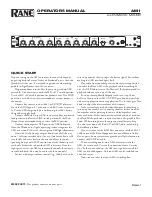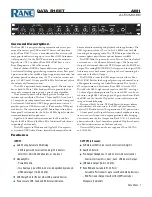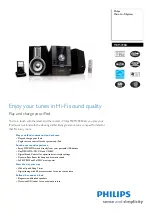
4 – Routing & assignment : Routing
TASCAM DM-4800
User’s Manual
61
Output routing
The output routing screen allows you to tie the logi-
cal outputs from the different parts of the DM-4800
to the physical output ports.
There are two such screens, one dedicated to the built
-in outputs of the DM-4800, and the other dedicated
to the outputs provided by any optional cards fitted in
the slots.
Use POD 3 to select the physical terminals to which
the output sources will be routed.
Select from:
•
TDIF1
,
TDIF2
,
TDIF3
The three TDIF format
connectors
•
ADAT
The optical ADAT output
•
DIGITAL OUT
The stereo digital outputs
•
ASN SEND
The eight analog assignable sends
•
EFF SEND1
,
EFF SEND2
These are not physical outputs,
but virtual patches to the inputs of the internal
effects.
Use the POD 4 control to select the output source.
Select from:
•
ALL
(all of the output sources mentioned below)
•
BUSS/DIRECT
The 24 busses, and any direct channel
outputs
•
AUX
The 12 aux sends
•
STEREO
The stereo buss
There is a second selection called
INPUT BYPASS
, which
allows you to select the same input sources as for
input routing (see “Input routing” on page 59). These
inputs are routed directly to the selected outputs, just
like a patchbay.
TIP
These “bypass sends” can be useful for physical format con-
version, etc. For example, if you have material on a medium
that can only be output in ADAT optical, for example, and
you need it transmitted to your DAW which has only TDIF
format inputs, with no extra processing, this feature allows
you to do just that.
Slot card outputs
The third page of this screen
allows the selection of the output sources (including
the input bypass sources) and their assignment to the
outputs of the optional slot cards fitted to the DM-
4800.
The exact configuration of the outputs of the slot
cards and their use depend on the actual slot card fit-
ted, as well as the surround mode currently selected.
For example, the FireWire expansion card currently
provides up to 24 destination channels to a DAW.
Consult the documentation relating to the appropri-
ate card(s) fitted to your system for details.
Insert patching
NOTE
It is important to note the difference between the hardware
inserts and the software inserts described here on the DM-
4800. The hardware inserts are completely in the analog
domain and apply only to the mic/line inputs.
The software inserts are available to many more
internal modules. Although these insert loops may
exit from the DM-4800 in either the analog or digital
domain, they may also remain completely within the
unit, using internal “patch” connections.
Figure 4.2: Routing outputs
















































